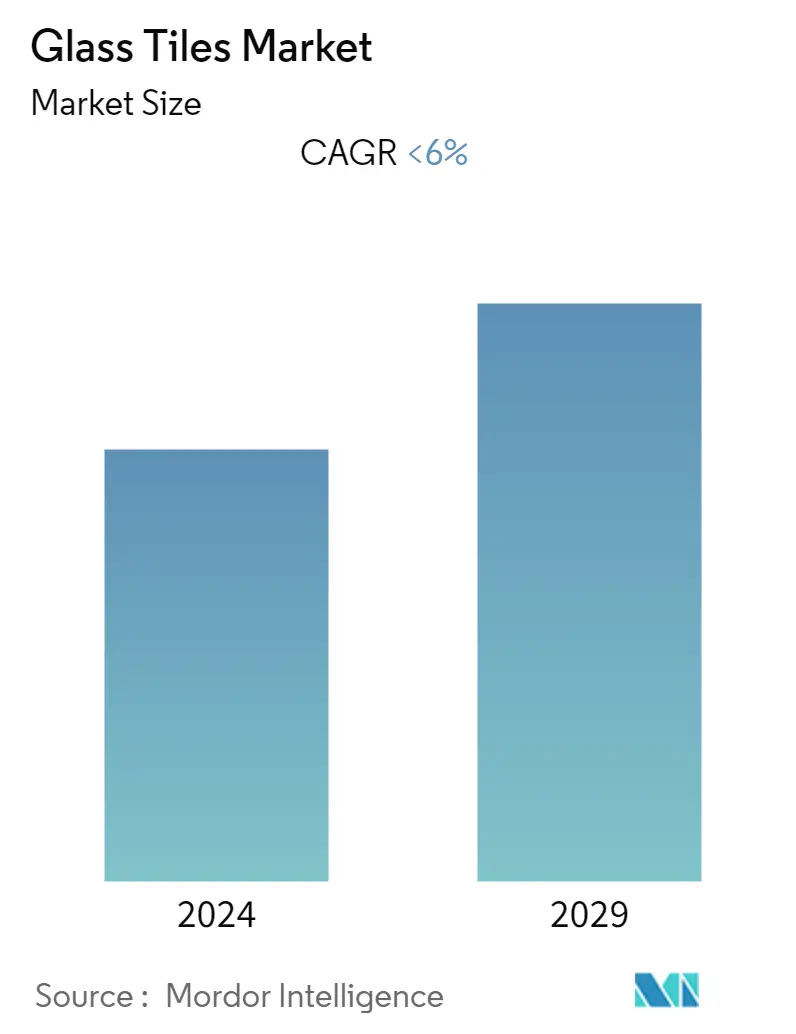Market Size of Glass Tiles Industry

| Study Period | 2019 - 2029 |
| Base Year For Estimation | 2023 |
| CAGR | 6.00 % |
| Fastest Growing Market | Asia Pacific |
| Largest Market | Asia Pacific |
| Market Concentration | Low |
Major Players*Disclaimer: Major Players sorted in no particular order |
Glass Tiles Market Analysis
The market for glass tiles is expected to grow at a CAGR of less than 6% during the forecast period. Major factors driving the market studied is emerging applications of expanding construction activities in Asia-Pacific and North America, development of eco-friendly manufacturing process.
- Increasing FDI in the real estate sector is likely to act as an opportunities.
- Asia-Pacific dominated the market across the globe with the largest consumption in a country such as India, China, etc.
Glass Tiles Industry Segmentation
The glass tiles market report includes:
| Manufacturing Process | |
| Smalti Tiles | |
| Fused Tiles | |
| Sintered Tiles | |
| Cast Tiles | |
| Other Manufacturing Processes (Slumping and Etched Glass Tiles) |
| Product Type | |
| Matte-finished Glass Tile | |
| Smooth Glass Tile |
| End-User Industry | |
| Residential | |
| Commercial | |
| Infrastructure |
| Geography | |||||||
| |||||||
| |||||||
| |||||||
| |||||||
|
Glass Tiles Market Size Summary
The glass tiles market is poised for growth, driven by expanding construction activities and the development of eco-friendly manufacturing processes, particularly in the Asia-Pacific and North America regions. The market is witnessing increased demand due to the versatility and aesthetic appeal of glass tiles, which are extensively used in commercial sectors such as high-rise buildings, multi-unit living spaces, hospitals, and shopping malls. The commercial construction industry is expected to experience steady growth, with significant contributions from developing economies like India, China, Brazil, and Mexico. In China, the construction of high-rise buildings is particularly notable, while Mexico's commercial sector is seeing substantial capital investment, further boosting the consumption of glass tiles.
In the United States, the glass tiles market is benefiting from a rise in multi-family residential buildings and urban migration, as evidenced by the increase in construction permits. The residential construction sector is projected to grow, with significant expansion in the southern region of the country. The non-residential construction sector is also on an upward trajectory, with public, educational, and healthcare building constructions contributing to the demand for glass tiles. The hospitality sector is increasingly adopting glass tiles for their aesthetic qualities, further driving market growth. The market is partially fragmented, with key players such as Marazzi, Villi USA, Saint Gobain, Arizona Tiles, and American Olean playing significant roles in shaping the industry's landscape.
Glass Tiles Market Size - Table of Contents
-
1. MARKET DYNAMICS
-
1.1 Drivers
-
1.1.1 Expanding Construction Activities in Asia-Pacific and North America
-
1.1.2 Development of Eco-friendly Manufacturing Process
-
-
1.2 Restraints
-
1.3 Industry Value-Chain Analysis
-
1.4 Porter's Five Forces Analysis
-
1.4.1 Bargaining Power of Suppliers
-
1.4.2 Bargaining Power of Consumers
-
1.4.3 Threat of New Entrants
-
1.4.4 Threat of Substitute Products and Services
-
1.4.5 Degree of Competition
-
-
-
2. MARKET SEGMENTATION
-
2.1 Manufacturing Process
-
2.1.1 Smalti Tiles
-
2.1.2 Fused Tiles
-
2.1.3 Sintered Tiles
-
2.1.4 Cast Tiles
-
2.1.5 Other Manufacturing Processes (Slumping and Etched Glass Tiles)
-
-
2.2 Product Type
-
2.2.1 Matte-finished Glass Tile
-
2.2.2 Smooth Glass Tile
-
-
2.3 End-User Industry
-
2.3.1 Residential
-
2.3.2 Commercial
-
2.3.3 Infrastructure
-
-
2.4 Geography
-
2.4.1 Asia-Pacific
-
2.4.1.1 China
-
2.4.1.2 India
-
2.4.1.3 Japan
-
2.4.1.4 South Korea
-
2.4.1.5 Rest of Asia-Pacific
-
-
2.4.2 North America
-
2.4.2.1 United States
-
2.4.2.2 Canada
-
2.4.2.3 Mexico
-
-
2.4.3 Europe
-
2.4.3.1 Germany
-
2.4.3.2 United Kingdom
-
2.4.3.3 Italy
-
2.4.3.4 France
-
2.4.3.5 Rest of Europe
-
-
2.4.4 South America
-
2.4.4.1 Brazil
-
2.4.4.2 Argentina
-
2.4.4.3 Rest of South America
-
-
2.4.5 Middle East & Africa
-
2.4.5.1 Saudi Arabia
-
2.4.5.2 South Africa
-
2.4.5.3 Rest of Middle East & Africa
-
-
-
Glass Tiles Market Size FAQs
What is the current Glass Tiles Market size?
The Glass Tiles Market is projected to register a CAGR of less than 6% during the forecast period (2024-2029)
Who are the key players in Glass Tiles Market?
Marazzi, Villi USA, Saint Gobain, Arizona Tiles and American Olean are the major companies operating in the Glass Tiles Market.

